21 Companion Plants To Grow With Eggplants
Looking for some plants to grow alongside your garden eggplants this season? There are many different options, including herbs, flowers, and other vegetables. In this article, gardening expert Merideth Corhs looks at her favorite plants to pair with eggplants in the garden.

Contents
Eggplant may not be quite as popular as other nightshades in American gardens, but it’s getting there as home cooks experiment with new cuisines. With large, gorgeous violet flowers and fruits that come in so many shapes and colors, growing eggplant may be just as fun as eating it!
It’s one of the perfect additions to your vegetable garden of zucchini, tomatoes, and bell peppers. However, eggplant is not immune to problems other plants also experience. Pests, weeds, disease, and other issues can damage or kill your eggplant crop.
Luckily, this beautiful veggie grows really well when planted near quite a few different plants. So whether you have a large or small space in your garden, you can look forward to diverse and beneficial “plant guilds” (companion plant combinations). Let’s dive in to discover the top companions to eggplant in the home garden.
Eggplant Companion Planting Benefits

Companion planting – or interplanting – has a long history in organic gardening. The concept is based on modeling how plants grow in nature – all mixed up together yet growing beautifully.
This is because an interconnected ecosystem works in harmony. All of the plants, animals, and bugs in an area enable the system to be stronger and more resilient to dangerous pests and diseases.
When growing your home garden, it can be beneficial to purposefully interplant certain herbs, flowers, and veggies with your eggplant to create your own complimentary ecosystem. Companion plants will either help a specific crop grow better or do many supportive jobs in the garden.
The potential benefits of companion planting include:
Pest Management
Aphids, flea beetles, tomato hornworms, whiteflies, spider mites, cabbage moths… These and many more pests can cause significant damage to your vegetable garden. Certain companion plants like marigolds, nasturtiums, and catnip can repel or trap certain pests. They should be planted near at-risk crops for maximum benefit.
Attract Pollinators and Beneficial Insects
Sometimes bees, wasps, ladybugs, and other predatory insects need a little encouragement to find their way into your garden. Pollinators will ensure you have a great yield from your flowering plants. Predatory insects will help keep pest populations down.
Replenish Nutrients in the Soil
Many of the vegetables we plant in our garden are heavy feeders. This means they seriously deplete the soil from the most vital nutrients needed for plants to grow. Some plants can add those vital nutrients directly back into the soil. Beans and peas are great examples of plants that help to fix nitrogen levels in the soil.
Encourage Better Growth or Flavor
Although this is more anecdotal than the others on the list, many gardeners believe that certain companion plants encourage better growth and even improve flavor in the plants around them. Basil is thought to do this for tomato plants.
Provide Shade
Sometimes plants need shade to grow well in the summer. Lettuce and greens are great examples of plants that do well under shade providing veggies like cucumbers.
Provide Ground Cover and Suppress Weeds
Plants that spread low across the ground like oregano and trailing nasturtiums do a great job of keeping the soil cool during the hottest parts of the summer. Their sprawling nature also does a great job of choking out any weeds that try to grow.
Similar Growing Needs
Sometimes companion planting is really simple. Certain plants – like nightshades – all share the same growing requirements for sunlight, water, soil, pH, and fertilizer. By planting these together, you make gardening very simple!
Mistakes to Avoid

Creating an interconnected ecosystem in your home garden is an exciting experience. You’ll get to experience flowers, herbs, and veggies growing together in harmony and benefiting each other along the way.
The visual appeal of an interplanted garden can also not be overstated. I know that I enjoy my gardening experience far more when I have created a beautiful and vibrant space!
With all that said, you can take companion planting too far and squeeze too many plants into one space. This can cause some issues that you’d be better off avoiding.
Some mistakes to avoid when companion planting include:
Overcrowding
No one likes their personal space to be invaded. Plants are no different. When interplanting, make sure you are leaving enough room around your eggplant so it doesn’t feel claustrophobic. This will also ensure proper air circulation, which can help ward off fungal diseases.
Competition for Water and/or Nutrients
This can be the biggest issue with poorly planned interplanting. Eggplants are both water and nutrient-hungry plants. You’ll need to manage watering and fertilizing accordingly to accommodate the needs of all the plants in your garden.
Creating Shade for a Sun-Loving Plant
Eggplant requires full sun to thrive and produce fruit. You don’t want to plant something tall like sunflowers or corn that can potentially block your eggplant from the sun it needs!
Flower Companions
Flowers are one of the better eggplant companions, as they encourage pollinators to visit your eggplants. Even though eggplants are self-pollinating, natural pollinators can help the process move along more efficiently. Flowers will also help attract predatory insects to your garden, which can help control pest populations from getting out of control.
Marigolds

In addition to attracting predatory insects and pollinators with their gorgeous yellow and orange flowers, marigolds are one of the most popular companion plants to keep away problematic eggplant pests.
These flowers secrete limonene, which is a chemical compound. This compound deters whiteflies and aphids.
Marigolds are also a popular line of defense in reducing harmful nematode populations. A compound in their roots called alpha-terthienyl will seep into the surrounding soil from the roots. Over several months, this toxins will kill off harmful nematodes and deter future infestations.
Benefits
Attracts pollinators and predatory insects, repels pests.
How to Plant
Plant marigolds every 1-2 feet throughout the vegetable garden at the same time you transplant the eggplant seedlings. Allow 12-18” of space between crops. If you are low on space, choose a compact French version.
Nasturtiums

Nasturtiums are an excellent sacrificial ‘trap plant’. Their natural peppery fragrance attracts certain pests like aphids and whiteflies. Instead of infesting your eggplants, these pests will feast on the flowers! Similar to marigolds, nasturtiums can attract predatory insects that will help keep pests away.
Nasturtiums are a popular vegetable companion plant for their ability to repel fungal diseases. And because they are a ground cover plant, they can help prevent water from splashing all over low-hanging eggplant leaves. This will help keep away diseases like powdery mildew, or other fungal soil diseases.
Benefits
Attracts pollinators and predatory insects, repels pests and traps others, and can help protect against fungal disease.
How to Plant
Give nasturtiums a trellis to grow along instead of planting them directly beside eggplant to avoid them casting too much shade on the eggplant.
Calendula

Commonly known as ‘pot marigold’, calendula is a bright yellow/orange flower that has a long history of use in medicinal and culinary preparations.
This member of the daisy family is a strong contributor in the vegetable garden as well, attracting pollinators and predatory insects like lacewings and hoverflies. There is also evidence that calendula will trap aphids and prevent them from bothering your eggplant.
Benefits
Attracts pollinators and predatory insects, repels pests and traps others.
How to Plant
Liberally sow the seeds throughout the garden in the spring. You can also interplant them at every row end for extra pest protection.
Herb Companions
Most fragrant herbs – mint, dill, oregano, chives – help deter pests from your eggplants. Since space is often at a premium in the home garden, we recommend choosing only one or two of these to plant nearby.
Borage
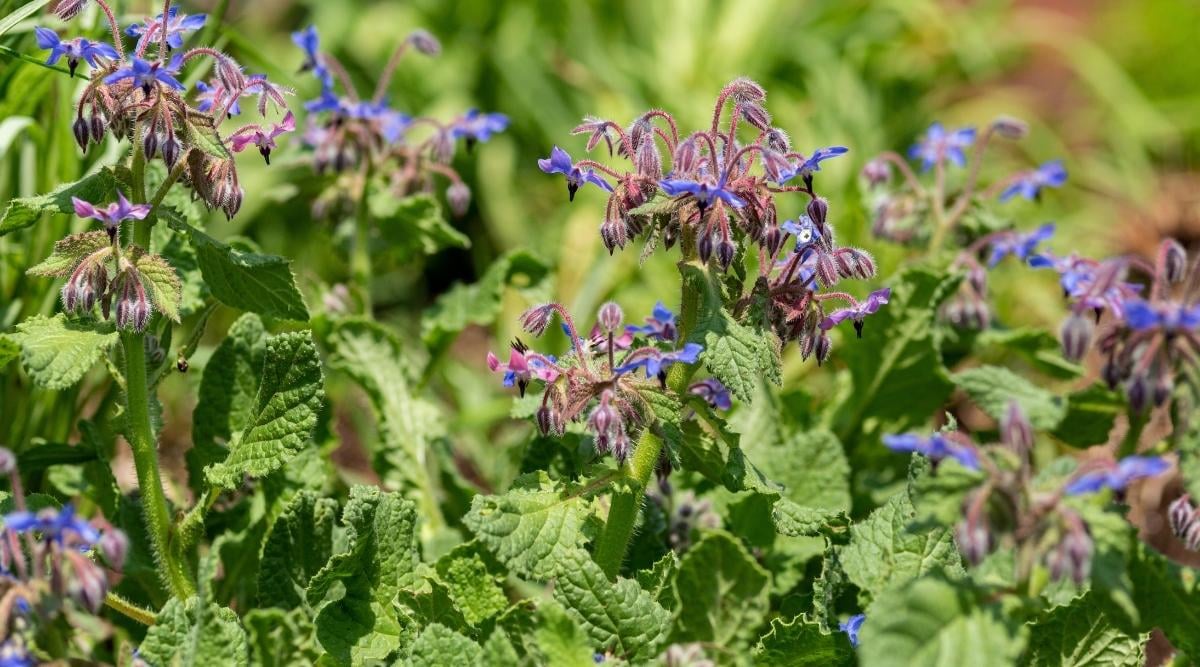
This is an often overlooked companion plant because it’s not often found at local nurseries (you’ll likely need to order seeds). Borage is a flowering herb that creates gorgeous star-shaped blue flowers.
Those flowers are highly attractive to both pollinators and predatory insects, meaning you’ll enjoy higher fruit yield and fewer pests. But borage is probably most famous for its ability to deter heavy-duty pests like tomato hornworms, cabbage worms, and armyworms.
Borage is also considered a bioaccumulator. Its deep roots not only aerate the surrounding soil, but they can also pull up trace minerals from deeper in the soil and make them available to your more shallow-rooted veggies.
Benefits
Attracts pollinators and predatory insects, repels pests, and accumulates nutrients.
How to Plant
Seed or transplant borage around the same time as eggplant. Plant it alongside the eggplants with about 18” or more between plants. These can grow quite tall, so be sure to plant them at the edge or border of the bed so eggplants can get the full sun they need.
Dill

Dill is a pretty incredible companion plant. The big umbel flowers of dill attract a host of pollinators and predatory insects. In fact, parasitic wasps, ladybugs, hoverflies, and lacewings are all attracted to those tall yellow flowers.
This will help keep all sorts of pest populations down including aphids, spider mites, and flea beetles. There is also anecdotal evidence that dill will enhance the growth of nearby plants.
Benefits
Attracts pollinators and predatory insects, enhances growth.
How to Plant
Grow dill anywhere near eggplant with about 6” in between plants.
Oregano

This Italian herb’s peppery aromatic leaves do an excellent job of repelling pests like aphids, cabbage moths, and spider mites. When allowed to flower, its delicate purple flowers are magnets to pollinators and predatory insects.
Keep in mind that this perennial herb will continue to grow and spread in place. If you don’t want it to take over your entire garden bed, be sure to keep it cut back. This way, you won’t choke out your young eggplants.
Benefits
Attracts pollinators and predatory insects.
How to Plant
Seed or transplant oregano around the edges or border of the vegetable garden. Leave about 8-10” between crops to allow oregano room to spread. Prune as needed.
Mint

Mints like spearmint or peppermint can help deter much-hated flea beetle, aphids, spider mites, and tomato hornworms. It is also believed that mint helps to improve the vigor and growth of nightshades like eggplant.
Keep in mind that mint is an invasive herb, so if you plant it in the ground, be prepared to aggressively cut it back as it spreads. Or you can plant it in a container where it won’t get out of hand.
Benefits
Repels pests.
How to Plant
Mint can become quite invasive, so it is best to plant it in neighboring beds or in a container nearby.
Chives
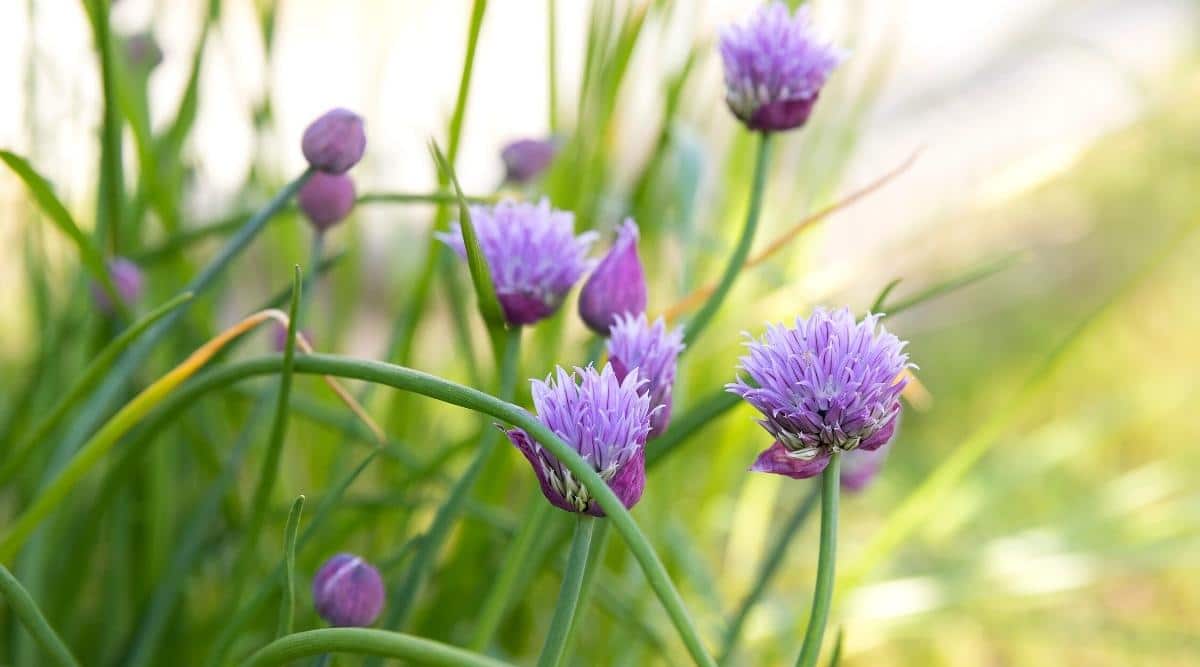
Chives may be the easiest herb to companion plant in your garden. They grow beautifully in the dappled shade created by growing eggplants and seem to thrive on neglect. But the best part is that sulfur compounds found in chives deter ap2hids.
If allowed to flower, chives produce the most beautiful purple ‘puffball’ of a flower that is almost magnetic to pollinators and predatory insects. They are also believed to improve the flavor in nearby plants.
Benefits
Attracts pollinators and predatory insects, repels pests, improves flavor.
How to Plant
Plant rooted clumps of chives int he spring after the last frost has passed. They thrive in full sun just like eggplant, so be sure to plant where they won’t get shaded.
Vegetable Companions
If you are really looking to get the most out of the space in your garden, planting multiple vegetables in one bed can enhance the growth of eggplant and expand the diversity of your meals. You just need to find other edible plants that have complementary growth habits and/or prefer similar growing conditions.
Peas

Peas and other legumes are all brilliant at contributing vital nitrogen to the soil. Since eggplants are heavy feeders, this is incredibly beneficial. Peas can also be trellised behind eggplant for maximum space saving efficiency.
When it comes to soil-dwelling bacteria, legumes can have a symbiotic relationship with certain bacteria types. Legumes provide carbohydrates to the bacteria, and the bacteria takes nitrogen from the air and feeds it to the roots of your legumes.
Benefits
Fixes nitrogen, maximizes space, improve vigor, and deter pests.
How to Plant
Seed summer peas on the northern side of peppers in rows. You’ll need at least 12 inches of space in between them. This way, you can trellis your peas without risking your eggplants getting shaded out.
Garlic

Garlic has long been a staple in cuisines around the world, so it makes perfect sense to grow it in your own garden. Unlike other vegetables, garlic is grown from cloves rather than seeds. Garlic is planted in the fall, overwinters, and is then harvested in the summer.
Because this crop has longer seasons, it requires a bit more preparation than other companions on this list.
The great news is that the sharp scent of garlic will help repel all sorts of pests like aphids, whiteflies, and flea beetles. Just make sure you don’t disturb the growing garlic bulbs when you plant your eggplant seedlings.
Benefits
Repels pests, maximizes space.
How to Plant
Garlic operates on the opposite season as eggplant. Garlic is a fall planted root vegetable that’s then harvested in the summer. This means you can start sowing garlic seeds while nearby eggplant are finishing off their growth cycle.
Beans

Green beans or shelling beans, pole beans or bush beans – it’s all the same when interplanting with eggplant. They are all wonderful companions for eggplant. Nitrogen-fixing legumes are all loved for the nutrient boost they provide in the soil.
Because they do not need the same nutrients, they do not compete. Beans also do an excellent job of deterring pests such as Mexican bean beetles.
Benefits
Improve vigor and add nitrogen.
How to Plant
Both bush beans and pole beans can work for companion planting. When planting pole beans, be sure the trellis is on the north side of the eggplants so it doesn’t shade them out.rnrnBush beans have a similar height and days to maturity as eggplants. Plant them around the same time and keep 18-24” of space between crops.
Peppers

If you are looking for a vegetable that prefers similar growing conditions as eggplant, peppers are a good choice. This is because they are both members of the nightshade family. Some gardeners will advise against it, but planting members of the same plant family can work if done correctly.
There are so many varieties that range from sweet, like bell peppers, to spicy, like habaneros. They all will work well with eggplant in the garden. Just be sure to plant a plant from another family in a rotation to avoid the reduction of nutrients in the soil.
Benefits
Add diversity, same growing requirements, and maximize harvest.
How to Plant
Give peppers adequate space from eggplant. Ensure there is plenty of fertility and water for both crops. Add other non-nightshade companions for maximum success.
Onions
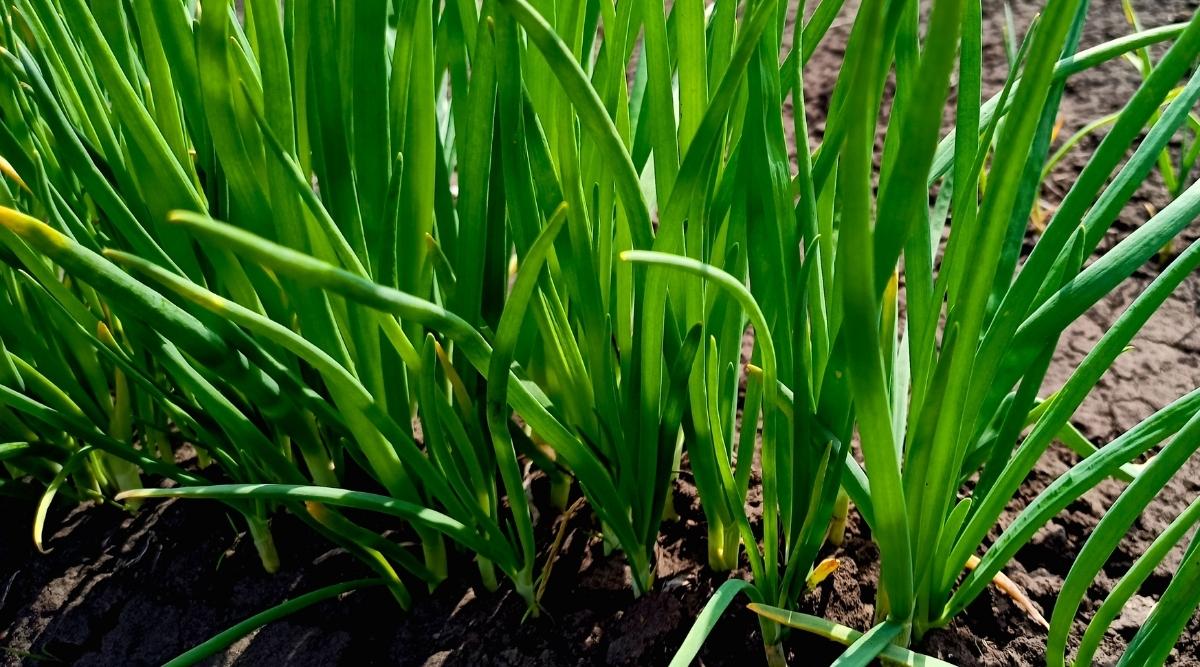
The pungent smell of all onion varieties naturally repels pests like aphids, beetles, and whiteflies. White onions have the most sulphuric compounds, so they tend to be the most pungent. These same compounds are what bring you to tears when chopping onions in the kitchen.
Their shallow growth habit ensures that the onion won’t compete with your eggplant for any resources in the soil. The foliage also won’t shade out your sun-loving eggplants.
Benefits
Repels pests, maximizes space.
How to Plant
Plant onions at the same time as eggplants. Plant them in a row 6-10” from the nearby eggplant seedlings and provide consistent moist conditions for both crops.
Potatoes

Another nightshade family member is potatoes. Since potatoes have similar growing requirements as eggplants, they are neutral companion plants. Well-draining acidic and fertile soil, moist conditions, and full sunlight for 6 or more hours a day are best for growing both vegetables.
In order to maintain the health of the soil, it is a good idea to rotate crops each season, especially when nightshade crops are planted. Doing so will keep the nutrients in the soil from dissipating, which will strengthen the growth of future plants.
Benefits
Add diversity, same growing requirements, and maximize harvest.
How to Plant
Plant eggplant 18-24” away from potatoes and avoid planting them where they may get mounded up. Ensure there is plenty of fertility for both crops. Add other non-nightshade companions for maximum success.
Radish

Radishes are among the easiest and fastest growing vegetables to grow and you will soon feel like you have hundreds of these little root veggies sprouting up in your garden.
Because radishes are so fast-growing, they are often ready to harvest before your eggplant is done growing. This makes for an excellent companion pairing since they add biodiversity to your garden bed and give you extra harvest from the same amount of space.
Benefits
Maximize space.
How to Plant
With only 30 days to maturity, there can be up to three successions of radishes during an eggplant’s growth cycle. Sow them 6-8” from the base of radish plants and provide even moisture for both crops.
Beets

These colorful root vegetables are grown for both their greens and roots and are used in a wide variety of cooking preparations. While many gardeners are familiar with red beets, golden beets are also a fine option. They are quite delicious and have a more mild flavor. No matter the color, the large round roots loosen and aerate the soil.
Beets are a cool season crop, which means you’ll need to sow seeds early in the spring or in the fall. These are easy to tuck alongside eggplant to maximize space. But if you’re planting beets in early spring, do your best not to disturb the root when planting your eggplant in later spring.
Benefits
Maximize space, loosens the soil.
How to Plant
Beets should be seeded about 6” away from eggplants.
Carrots
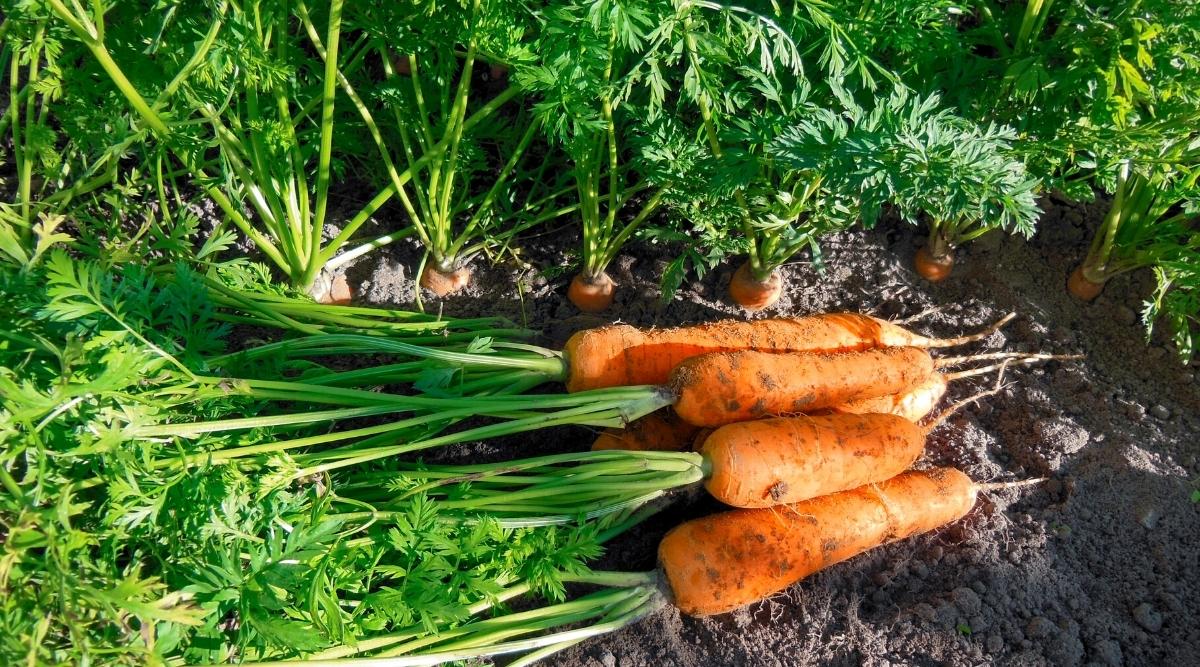
While you can certainly grow carrots in the spring for an early summer harvest, take care that the carrot greens don’t shade your young eggplants. For this pairing, you may want to focus on a midsummer planting for a fall harvest. This way, you’ll maximize space in your garden while mitigating any issues with sun exposure.
Don’t worry, your carrots will grow just fine if partially shaded by your mature eggplant. Carrots may be a bit smaller when grown in areas with partial shade, but they’ll taste just as sweet!
Benefits
Maximize space.
How to Plant
When planting eggplants, direct seed the carrots about 6” from the base of the eggplants for proper airflow and irrigation.
Kohlrabi

Most people are first exposed to kohlrabi through their local CSA or farmer’s markets. The bulb looks like small, hard cabbage. But it actually tastes like a delicious combination of spicy radish and cabbage. The great news is that it’s really easy to grow at home and makes an excellent companion to eggplant.
Kohlrabi deters pests like aphids, flea beetles, and cabbage worms. As a cool season crop, you’ll plant this ahead of your eggplant, which means it will be mature enough to really make a difference with those pests.
Benefits
Repels pests.
How to Plant
Space Kohlrabi apart by about 2” and plant near the edges of the garden bed.
Swiss Chard

Swiss chard is a popular late season green. It can be grown well into the fall, and is a perfect rotational crop for your garden. Chard is also a really beautiful addition to the home garden. The rainbow variety is especially stunning with shades of orange, pink, purple, and red stalks set against vibrant green leaves.
Swiss chard’s shallow root systems do not compete for resources with your eggplant, and they’ll grow just fine in the dappled shade thrown by mature plants.
Benefits
Maximize space.
How to Plant
Plant chard about 12” away from eggplants. The outer leaves should be harvested regularly by snapping off at the base of the stem. Come back for repeated harvests throughout all of summer and fall.
Lettuce
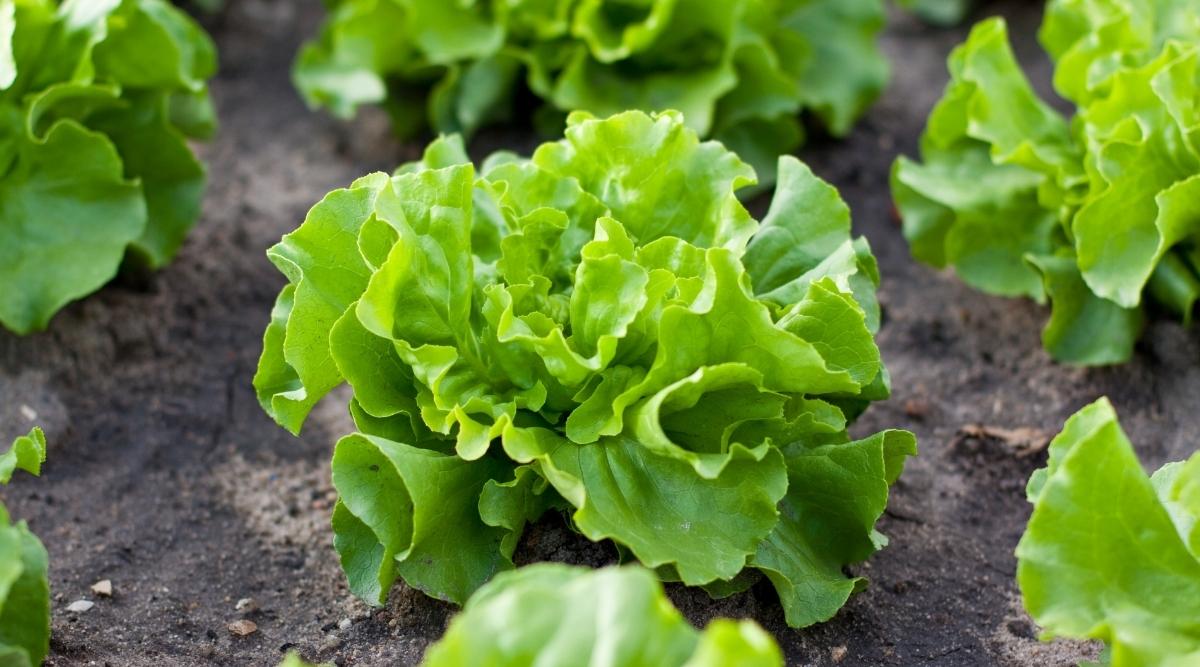
While not related to pest control or plant health, lettuce benefits eggplant as ground cover. This helps with moisture retention in the soil and weed prevention.
In return, the eggplant provides the lettuce much-needed shade that is needed to grow in the hot summer months. They are a couple destined to be together in the garden!
Benefits
Utilize unused space, provides ground cover.
How to Plant
About 1-2 weeks after planting eggplants, seed or transplant lettuce in a row alongside the eggplants, with 6-10” of space in between each.
Spinach
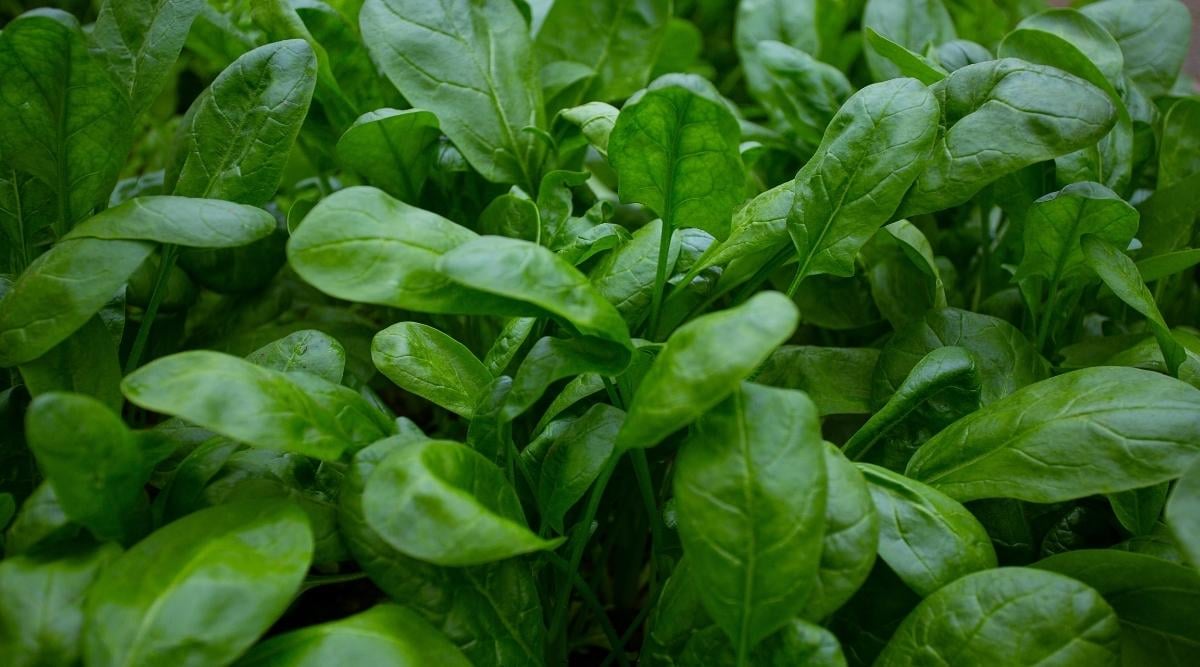
Just like with lettuce, this pairing is all about the spinach providing ground cover and the eggplant providing shade. It can be quite difficult to grow spinach in the summer, but you’ll have a far better chance if it’s growing in the cool shade thrown by your mature eggplants.
Spinach has similar growing preferences as eggplant, such as fertile and well-draining soil that’s moist. It is also possible to grow these two in a container together.
Benefits
Utilize unused space, provides ground cover.
How to Plant
Baby spinach should be sown about 6-8” away from eggplants. Harvest the spinach by cutting from the base of the leaves. Spinach can also be succession planted.
Plants to Avoid With Eggplant

Avoid planting fennel near your eggplant. Fennel is well known for inhibiting growth in many plants and eggplant is unfortunately on that list. Here are a few others that you’ll want to avoid when growing eggplant:
- Geraniums
- Pumpkins
- Corn
- Melons
Geraniums are another plant to avoid. They can host certain diseases that easily jump to eggplant such as blight so it’s best to keep those relegated to other areas of your garden.
Final Thoughts
Now that you know about the host of herbs, flowers, and veggies you can successfully companion plant with your eggplant, the sky’s the limit. We find that it’s a great strategy to plan out your garden ahead of time so you can thoughtfully choose where to place your plants. This will ensure you can maximize your space, improve pollination, and deter pests without overcrowding your garden.







